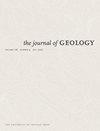受U-Pb年龄和潜在现场数据约束的内华达山脉岩基的增量安置
IF 1.3
4区 地球科学
Q2 GEOLOGY
引用次数: 1
摘要
大量的花岗岩岩浆是如何在拥挤的汇聚区侵位的,目前仍存在争议。空间问题对大量岩基(如科迪勒兰岩基)来说意义重大,因为花岗岩岩浆无法自行进入地壳,而且区域构造环境是收缩的。已经提出了区域和局部模型来解决这个问题,但这些笨拙的模型在时空框架中是有限的,不可能推广到大型中生代岩基中的重复脉冲。为了研究内华达山脉岩基(SNB)在不同水平的增量侵位,将潜在的野外数据与年龄数据库相结合。三个脉冲在中生代与区域事件同时递增侵位,表明了一个造山带起源,并暗示了相同的结构框架。势场数据表明,同造山带的存在适应了馈线带的向西迁移。在白垩纪Sierra嵴剪切带和Kern Canyon断裂带下方的SNB内岩浆活动停止之前,这些补给带在三叠纪和侏罗纪从西北向东南倾斜穿过主岩基体下方。结构控制的补给带适应了SNB中生代爆发岩浆作用的时空分布,其受到上升深成岩体下方小型补给岩脉的干扰。上升的深成岩体在中生代解剖了内华达山脉的西部,并延伸到SNB西部的萨利纳斯山谷地区。最后,提出了推力弯曲作为空间问题的替代模型;造山应力越高,花岗岩岩浆的可用空间就越大。本文章由计算机程序翻译,如有差异,请以英文原文为准。
Incremental Emplacement of the Sierra Nevada Batholith Constrained by U-Pb Ages and Potential Field Data
How voluminous granite magmas are emplaced in congested convergent regimes is still debated. The space problem is significant for voluminous batholiths, such as Cordilleran batholiths, because granite magmas cannot create their own way into the crust, and the regional tectonic circumstances are contractional. Both regional and local models have been suggested to solve this problem, but these awkward models are limited in space-time framework without any possibility for generalization to repeated pulses within large Mesozoic batholiths. To investigate the Sierra Nevada batholith (SNB) incremental emplacement at different levels, potential field data were integrated with the age database. Three pulses emplaced incrementally during the Mesozoic era contemporaneously with regional events, suggesting a synkinematic origin and implying the same structural framework. The potential field data reveal that the presence of a synorogenic fault zone accommodates the westward migration of the feeder zone. These feeder zones passed underneath the main batholithic body obliquely from northwest to southeast in the Triassic and Jurassic, before the cessation of magmatism within the SNB underneath the Sierra crest shear zone and Kern Canyon fault zone in the Cretaceous. The structurally controlled feeder zones accommodate the spatiotemporal distribution of the SNB Mesozoic flare-ups magmatism, which is disturbed by small feeder dikes underneath the rising plutons. The rising plutons dissected the western part of the Sierra Nevada during the Mesozoic and extended to the Salinas Valley region to the west of the SNB. In conclusion, bends on thrusts are proposed as an alternative model for the space problem; the higher the orogenic stress, the greater the space available for granite magma.
求助全文
通过发布文献求助,成功后即可免费获取论文全文。
去求助
来源期刊

Journal of Geology
地学-地质学
CiteScore
3.50
自引率
5.60%
发文量
0
审稿时长
3 months
期刊介绍:
One of the oldest journals in geology, The Journal of Geology has since 1893 promoted the systematic philosophical and fundamental study of geology.
The Journal publishes original research across a broad range of subfields in geology, including geophysics, geochemistry, sedimentology, geomorphology, petrology, plate tectonics, volcanology, structural geology, mineralogy, and planetary sciences. Many of its articles have wide appeal for geologists, present research of topical relevance, and offer new geological insights through the application of innovative approaches and methods.
 求助内容:
求助内容: 应助结果提醒方式:
应助结果提醒方式:


